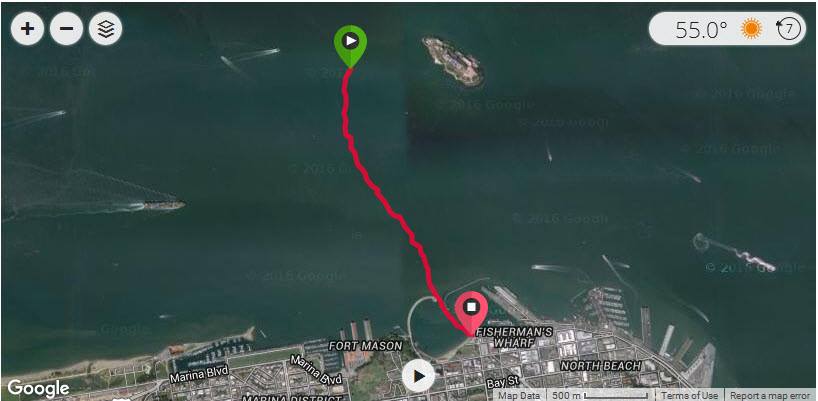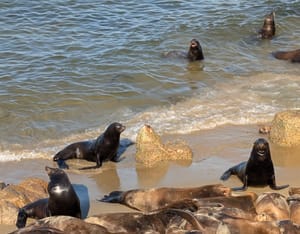Yesterday I realized a dream I’ve had ever since I started open water swimming around 2010. I swam from Alcatraz back to San Francisco. It’s about 1.25 miles though we covered a bit more water than that due to fighting the current a little. In all, it took me one hour and 13 minutes in pretty calm and 60-62 degree water. I was swimming with a group of 5 other swimmers, plus a pilot, Bill Wygant, the president of the South End Rowing Club, who took us out to the island and then watched over us as we swam back.
I saw cormorants, a huge flock of pelicans, a speeding pilot boat, a big-ass Hanjin freighter thankfully well behind us, and a cute orange jelly — a few feet below me and out of reach. (I am a bit freaked out by jellies, and while it was pretty to look at, I’m glad I didn’t touch it.) Plus I got to see a gorgeous sunrise over Alcatraz.
It was a terrific experience.
When I first dipped my toe into San Francisco Bay, at Coyote Point, in 2010, swimming Alcatraz was something that seemed only distantly achievable. I’ve been swimming all my life, but never swam on a team and never learned to swim distances. At the time I could barely swim 100 yards before needing to catch my breath. I realized pretty quickly that if I was going to keep going into the Bay I’d need to learn how to swim better. Over the next few years I pursued it only sporadically, though. I studied Total Immersion videos, DVDs, and books, and went through a whole series of TI-based drills to correct the obvious “windmilling” flaws in my stroke. I tried to get in laps at the Y when I could. And I returned to Coyote Point occasionally, never venturing too far from shore.
But last year I took a stronger interest and joined a Master’s swim team at Burlingame Aquatics in September. US Master’s Swimming has an impressive sounding name, until you realize that “Masters” just means “old,” and “old” means “anyone over 18.” “Adult Swimming” would probably be more accurate. In other words, you can be slow and have a terrible stroke, like me, and get along just fine in Master’s swimming, as long as you’re a grownup. You don’t have to compete in swim meets. Heck, you don’t even have to finish the workouts. The main advantage is that you get some coaching, and for me that structure was critical. It forced me to swim longer than I would on my own (2,000+ yards per workout instead of 1,000-ish as I would do if undirected). It also provided a context where I could learn from my lane-mates and my coach. And my coach, Cory Ferrara, has been amazingly encouraging and constructive.
With the help of these workouts I was able to improve my 100-yard interval (the pace I can swim on a regular, repeatable basis) from about 2 minutes and 10 seconds to about 1:45 or 1:50. I can sprint a 100 in 1:30, which was unthinkable a year ago. That’s still not very fast, and there are still a lot of things I can improve, but I’m on the right track.
Most importantly to me, I can swim comfortably for longer amounts of time. Last weekend I was in the water for an hour and 35 minutes on a challenging swim from Pier 7 to Aquatic Park, just as the tide was turning and started to push against us. And then there was Alcatraz yesterday. Both swims were challenging but well within my capabilities.
I also joined the South End Rowing Club, an organization that’s been in San Francisco since 1873 and is devoted to rowing, swimming, running, and handball. But mostly it seems dominated by swimmers, people like me who really enjoy swimming in the Bay. The South End has provided lots of opportunities to go on shorter swims around the Bay, and to pick up advice and encouragement from other swimmers. (Some of whom have swum Alcatraz 1,000 times or more!) Plus, it has a sauna.

Alcatraz course, July 13
Isn’t it cold, you may ask? Well, yes. But here’s the amazing thing: You get used to it. Sure, that initial shock of cold is always there. But while I used a wetsuit when swimming in colder water before, last winter I decided that I would try doing without it. As the temperature dropped below 65 to 60 to 55 over the course of a couple months, I just kept going in the water, a couple times a week. And I acclimated to it. The process is partly psychological but I believe also physiological, and your body actually gets better and better able to tolerate cold water. (And a sauna helps a lot at the end of your swim.)
For me, swimming in the Bay or the ocean is a lot like hiking. I do it because it connects me to the world, because I see things like cormorants and jellyfish (and sometimes sea lions) up close, and because it makes me feel relaxed and alive.
So that was the big thing about Alcatraz. I achieved a goal I’d set for myself years ago, yes. But in another way, it was just another beautiful swim in the jade-green water. And I’m sure I’ll be doing that swim again soon.



